
The Monroe Avenue Commercial Buildings, also known as the Monroe Block, is a historic district located along a block-and-a-half stretch at 16-118 Monroe Avenue in Detroit, Michigan, just off Woodward Avenue at the northern end of Campus Martius. The district was designated a Michigan State Historic Site in 1974 and listed on the National Register of Historic Places in 1975. The thirteen original buildings were built between 1852 and 1911 and ranged from two to five stories in height. The National Theatre, built in 1911, is the oldest surviving theatre in Detroit, a part of the city's original theatre district of the late 19th century, and the sole surviving structure from the original Monroe Avenue Commercial Buildings historic period.

The Abrams Building was located at South Pearl Street and Hudson Avenue in Albany, New York, United States. It was a brick commercial building constructed in the 1880s. In 1980 it was listed on the National Register of Historic Places.

The Main Street Historic District in Lake Geneva, Wisconsin is a 2.5-acre (1.0 ha) historic district that was listed on the National Register of Historic Places on January 11, 2002. The listing was amended in some way in a revised listing on March 5, 2002. In 2002, there were 20 buildings in the district that were deemed to contribute to its historic character.

The Masonic Temple Building is a historic Prairie-style building in Oak Park, Illinois, at the corner of Oak Park Avenue and Lake Street. It is in the Ridgeland-Oak Park Historic District and was individually listed on the National Register of Historic Places in 1982.
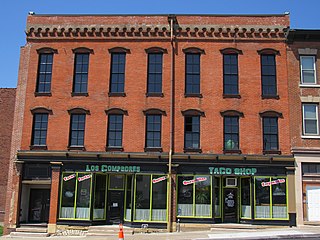
The Wupperman Block/I.O.O.F. Hall is a historic building located just north of downtown Davenport, Iowa, United States. It was individually listed on the National Register of Historic Places in 1983. In 2020 it was included as a contributing property in the Davenport Downtown Commercial Historic District.

The Ault Store is a historic commercial building in Dundas, Minnesota, United States. The building was placed on the National Register of Historic Places (NRHP) on April 6, 1982.

The Rosenwald Building is a historic building located in Downtown Albuquerque, New Mexico. Designed by Henry Trost of the El Paso firm of Trost & Trost and built in 1910, it was the first reinforced concrete building in the city. It is a massive three-story building with a two-story recessed entrance and simple geometric ornamentation. The building was added to the New Mexico State Register of Cultural Properties and the National Register of Historic Places in 1978.
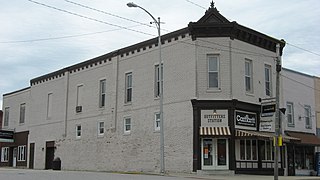
The Palace Lodge is a historic commercial building in the small town of Winslow, Indiana, United States. Since its construction in the late nineteenth century, the building has been the location of several businesses, the meeting place for two different secret societies, and the center of the town's commercial district. It has been declared a historic site because of its historically significant architecture.

The Sundberg Block was a commercial building located at 517–523 Iron Street in Negaunee, Michigan, United States. It was listed on the National Register of Historic Places in 2011. It was later demolished in November 2016 and removed from the NRHP in 2020.

The Gately Building is a historic commercial building at 337–353 Main Street in downtown Pawtucket, Rhode Island The building was listed on the National Register of Historic Places in 2012. In 2015, the property was renovated into a 13-unit apartment building.

The Goodyear Block, also known as the Arbeiter Block is a commercial building located at 138 E. Main Street in Manchester, Michigan. It was listed on the National Register of Historic Places in 1993.
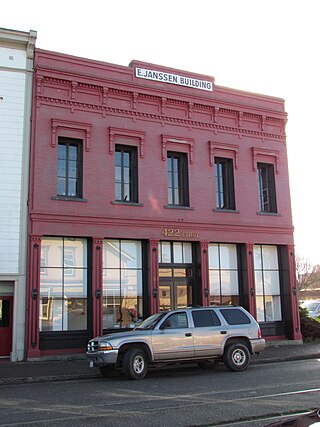
The E. Janssen Building at 422 First Street, Eureka, California, is a two-story Italianate commercial building. It was built in 1875 to be a hardware and general merchandise store. In 1973, it was the first building in Eureka to be placed on the United States National Register of Historic Places, and it was listed as a contributing property of the National Register Old Town Eureka Historical District in 1991. From 1998 to 2016, the building housed the HSU First Street Gallery, an art gallery run by Humboldt State University.

Butlers' Store is a group of three historic commercial buildings in New Hope, Alabama. The Butler family began their dry goods and hardware business in the 1850s, and in 1909 built 2 two-story buildings on New Hope's main street. The central building was used for a general merchandise, dry goods, and hardware store and office space. It features a five-bay façade with cast iron columns separating large glass panes atop wood panel bulkheads on the storefront level. Large transom windows over the main windows cast light into the room with 18-foot (5.5-meter) ceilings and a mezzanine in the rear. The northern building was used for a bank until the Great Depression, after which it was connected to the central building and used as a grocery store. It is shorter than the central building, due to a lower ceiling on the ground floor. Both of the older buildings have brick corbelling and slightly arched second-floor windows. The one-story southern building was constructed in 1939 and housed a furniture store. Three bays in width, its ground floor appearance is similar to the northern building, but its roofline is more plain.
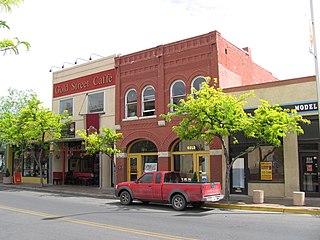
The Hope Building is a historic commercial building in Albuquerque, New Mexico. Built in 1894, it is one of the only surviving 19th century buildings in Downtown Albuquerque. It was added to the New Mexico State Register of Cultural Properties and the National Register of Historic Places in 1980.

The S. H. Kress Building is a historic commercial building in downtown Albuquerque, New Mexico. Built in 1925 by the S. H. Kress & Co. department store chain, it is notable as a well-preserved early 20th century retail building. It was added to the New Mexico State Register of Cultural Properties and the National Register of Historic Places in 1984.

The Employees' New Dormitory and Club, also known as Building 232, is a historic building in Albuquerque, New Mexico. Built in 1931, it is notable as the only surviving building of the Albuquerque Indian School, which operated at this location from 1882 to 1976. It was added to the New Mexico State Register of Cultural Properties in 1981 and the National Register of Historic Places in 1982.

The Gabriel Richard Building, also known as the Weil and Company Building, is high-rise located at 305 Michigan Avenue in Downtown Detroit, Michigan. It was listed on the National Register of Historic Places in 2017. The building will open as a residential apartment building known as the Gabriel Houze in late 2017.
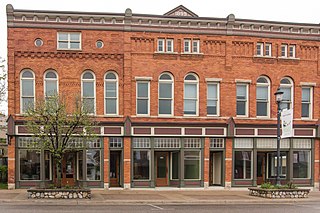
The Votruba Block is a commercial building located at 112 Main Street in East Jordan, Michigan. It was listed in the National Register of Historic Places in 2008. It is next to, and shares a wall with, the East Jordan Lumber Company Store Building; both buildings have been rehabilitated to form the Main Street Center office complex.

The Ogilvie Building is a commercial building located at 4443 Main Street in Port Hope, Michigan. It was listed on the National Register of Historic Places in 1987.

The Highland Hotel, also known as the Hudson Hotel, is a historic hotel building in the Huning Highlands neighborhood of Albuquerque, New Mexico. It was built in 1906 and operated as a hotel until the 1970s. The building was restored and converted to office space in 1983–84. It is notable as one of the few surviving examples of early-20th-century Commercial Style architecture in the city, which was once common.






















